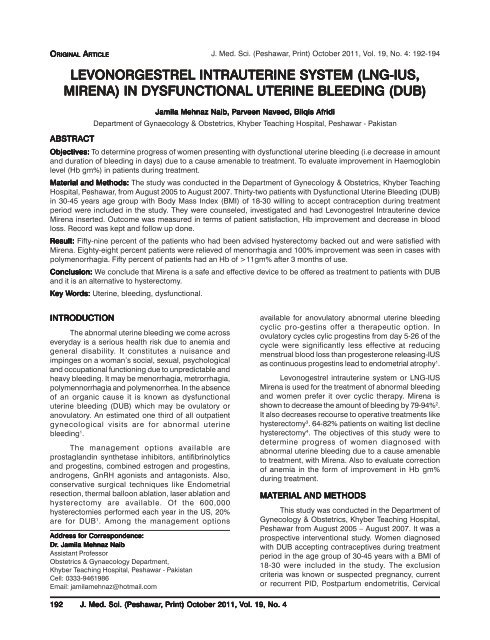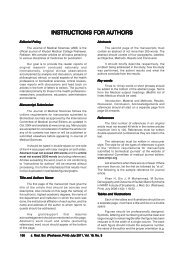Download Full Pdf
Download Full Pdf
Download Full Pdf
Create successful ePaper yourself
Turn your PDF publications into a flip-book with our unique Google optimized e-Paper software.
ORIGINAL<br />
ARTICLE<br />
J. Med. Sci. (Peshawar, Print) October 2011, Vol. 19, No. 4: 192-194<br />
LEVONORGESTREL INTRAUTERINE SYSTEM (LNG-IUS,<br />
MIRENA) IN DYSFUNCTIONAL UTERINE BLEEDING (DUB)<br />
ABSTRACT<br />
Jamila Mehnaz Naib, Parveen Naveed, Bilqis Afridi<br />
Department of Gynaecology & Obstetrics, Khyber Teaching Hospital, Peshawar - Pakistan<br />
Objectives: To determine progress of women presenting with dysfunctional uterine bleeding (i.e decrease in amount<br />
and duration of bleeding in days) due to a cause amenable to treatment. To evaluate improvement in Haemoglobin<br />
level (Hb gm%) in patients during treatment.<br />
Material and Methods: The study was conducted in the Department of Gynecology & Obstetrics, Khyber Teaching<br />
Hospital, Peshawar, from August 2005 to August 2007. Thirty-two patients with Dysfunctional Uterine Bleeding (DUB)<br />
in 30-45 years age group with Body Mass Index (BMI) of 18-30 willing to accept contraception during treatment<br />
period were included in the study. They were counseled, investigated and had Levonogestrel Intrauterine device<br />
Mirena inserted. Outcome was measured in terms of patient satisfaction, Hb improvement and decrease in blood<br />
loss. Record was kept and follow up done.<br />
Result: Fifty-nine percent of the patients who had been advised hysterectomy backed out and were satisfied with<br />
Mirena. Eighty-eight percent patients were relieved of menorrhagia and 100% improvement was seen in cases with<br />
polymenorrhagia. Fifty percent of patients had an Hb of >11gm% after 3 months of use.<br />
Conclusion: We conclude that Mirena is a safe and effective device to be offered as treatment to patients with DUB<br />
and it is an alternative to hysterectomy.<br />
Key Words:<br />
Uterine, bleeding, dysfunctional.<br />
INTRODUCTION<br />
The abnormal uterine bleeding we come across<br />
everyday is a serious health risk due to anemia and<br />
general disability. It constitutes a nuisance and<br />
impinges on a woman’s social, sexual, psychological<br />
and occupational functioning due to unpredictable and<br />
heavy bleeding. It may be menorrhagia, metrorrhagia,<br />
polymennorrhagia and polymenorrhea. In the absence<br />
of an organic cause it is known as dysfunctional<br />
uterine bleeding (DUB) which may be ovulatory or<br />
anovulatory. An estimated one third of all outpatient<br />
gynecological visits are for abnormal uterine<br />
bleeding 1 .<br />
The management options available are<br />
prostaglandin synthetase inhibitors, antifibrinolytics<br />
and progestins, combined estrogen and progestins,<br />
androgens, GnRH agonists and antagonists. Also,<br />
conservative surgical techniques like Endometrial<br />
resection, thermal balloon ablation, laser ablation and<br />
hysterectomy are available. Of the 600,000<br />
hysterectomies performed each year in the US, 20%<br />
are for DUB 1 . Among the management options<br />
Address for Correspondence:<br />
Dr. . Jamila Mehnaz Naib<br />
Assistant Professor<br />
Obstetrics & Gynaecology Department,<br />
Khyber Teaching Hospital, Peshawar - Pakistan<br />
Cell: 0333-9461986<br />
Email: jamilamehnaz@hotmail.com<br />
available for anovulatory abnormal uterine bleeding<br />
cyclic pro-gestins offer a therapeutic option. In<br />
ovulatory cycles cylic progestins from day 5-26 of the<br />
cycle were significantly less effective at reducing<br />
menstrual blood loss than progesterone releasing-IUS<br />
as continuous progestins lead to endometrial atrophy 1 .<br />
Levonogestrel intrauterine system or LNG-IUS<br />
Mirena is used for the treatment of abnormal bleeding<br />
and women prefer it over cyclic therapy. Mirena is<br />
shown to decrease the amount of bleeding by 79-94% 2 .<br />
It also decreases recourse to operative treatments like<br />
hysterectomy 3 . 64-82% patients on waiting list decline<br />
hysterectomy 4 . The objectives of this study were to<br />
determine progress of women diagnosed with<br />
abnormal uterine bleeding due to a cause amenable<br />
to treatment, with Mirena. Also to evaluate correction<br />
of anemia in the form of improvement in Hb gm%<br />
during treatment.<br />
MATERIAL AND METHODS<br />
This study was conducted in the Department of<br />
Gynecology & Obstetrics, Khyber Teaching Hospital,<br />
Peshawar from August 2005 – August 2007. It was a<br />
prospective interventional study. Women diagnosed<br />
with DUB accepting contraceptives during treatment<br />
period in the age group of 30-45 years with a BMI of<br />
18-30 were included in the study. The exclusion<br />
criteria was known or suspected pregnancy, current<br />
or recurrent PID, Postpartum endometritis, Cervical<br />
192<br />
J. Med. Sci. (Peshawar<br />
eshawar, , Print) October 2011, Vol. ol. 19, No. 4
dysplasia, undiagnosed abnormal vaginal bleeding,<br />
congenital abnormality of uterus, acute liver disease<br />
and previous history of deep venous thrombosis.<br />
Patients were counseled, investigated and informed<br />
consent taken. Mirena was inserted as per instructions.<br />
A record was kept of followup visits at 1, 3, 6 and 9<br />
months and 1 year and 2 years after insertion.<br />
Outcome was measured in terms of patient<br />
satisfaction, improvement in Hb% and decreased<br />
blood loss (amount and number of days, presence /<br />
absence of clots) and the results were compiled<br />
according to the above mentioned outcome measures.<br />
RESULTS<br />
Table 1 shows the age distribution in patients<br />
selected for Mirena use. Maximum patients i.e 43.75%<br />
were in the age range of 35-39 years. Table 2 shows<br />
change in Hb% with treatment. The maximum number<br />
of patients had an overall reduction of days of<br />
bleeding from an average 9 to 4.5-5 days.The bar<br />
diagram Figure 1 clearly shows the difference made<br />
by Mirena. Table 3 shows the improvement of<br />
symptoms. The early problems faced by patients with<br />
Mirena insertion were as follows. Eight (25%) patients<br />
had backache which eased with simple analgesics.<br />
21.8% patients had short term spotting and irregular<br />
bleeding. Four percent had some infection and 1<br />
patient expelled Mirena which was reinserted. 59.37%<br />
Age range<br />
Table 1: Age distribution (n = 32)<br />
Frequency<br />
30-34 years 7 (21.8%)<br />
35-39 years 14 (43.75%)<br />
40-44 years 11 (34.37%)<br />
Mean age was 38 years<br />
Standard deviation was ±7.62<br />
Table 2: Change in Hb% with Mirena use (n=32)<br />
Hb gm %<br />
No. of patients<br />
No. of patients<br />
at insertion<br />
3 months after<br />
of Mirena<br />
insertion of<br />
Mirena<br />
< 9 gm % 13 (40.62%) 0%<br />
9.1–10.1 gm% 14 (43.75%) 5 (15.62%)<br />
10 – 11 gm% 5 (15.62%) 11 (34.37%)<br />
> 11gm% 0% 16 (50%)<br />
Before Mirena insertion<br />
Mean hemoglobin level was 9 gm%<br />
Standard deviation was ± 2.16<br />
After Mirena insertion<br />
Mean hemoglobin level was 11 gm%<br />
Standard deviation was ± 3.86<br />
Table 3: Patients reporting symptom relief (n=32)<br />
Group<br />
Days of bleeding<br />
10<br />
9<br />
8<br />
7<br />
6<br />
5<br />
4<br />
3<br />
2<br />
1<br />
0<br />
Fig. 1: Reduction in days of bleeding after 3 months<br />
and 6 months of treatment<br />
patients who had been advised hysterectomy decided<br />
against it and were satisfied with Mirena.<br />
DISCUSSION<br />
SION<br />
Symptoms<br />
No. of<br />
patients<br />
reporting<br />
symptoms<br />
10 Patients 15 Patients 07 Patients<br />
No. of<br />
patients<br />
relieved<br />
Menorrhagia Menor- 18 16<br />
rhagia/ (88.88%)<br />
Dysmenorrhea<br />
Irregular 1. Polymenor- 8 8 (100%)<br />
Cycle<br />
rhea<br />
2. Metrorrhagia 2 2 (100%)<br />
3. Menomet- 1 1 (100%)<br />
rorrhagia<br />
4. Polymenor- 3 2<br />
rhea + Me- (66.66%)<br />
norrhagia<br />
days of<br />
bleedind<br />
before<br />
treatment<br />
3 months of<br />
treatment<br />
6 months of<br />
treatment<br />
Mirena is used for the treatment of abnormal<br />
bleeding and women are more satisfied and willing to<br />
continue with Mirena compared to cyclic therapy.<br />
Mirena has shown to decrease the amount of<br />
bleeding over time by 79-94%. Nineteen (59.37%) out<br />
of 32 patients who had been advised hysterectomy in<br />
our study decided against it. This is comparable to<br />
other studies in which 64-82% patients who were on<br />
the waiting list declined hysterectomy 5,6,7 . In a study<br />
published in 2009 the 5 year intervention free<br />
percentage of patients with LNG-IUS was 70.6% (SD +<br />
3.3%) 8 . Another study reports that in improperly<br />
assessed and selected obese, premenopausal women<br />
with DUB at high risk for traditional therapies, the<br />
LNG-IUS was an effective treatment in 70% of<br />
patients 9,10 . In our study the overall reduction of days<br />
of bleeding was from an average of 9 days to 4.5-5<br />
days which is comparable to other studies 11,12,13 .<br />
J. Med. Sci. (Peshawar<br />
eshawar, , Print) October 2011, Vol. ol. 19, No. 4 193
In case of dysfunctional uterine bleeding, the use<br />
of medical treatment should be considered as the first<br />
line treatment. Progestogens are often used in this<br />
condition and LNG-IUS is very effective 14,15 . After 3<br />
months of insertion of Mirena a marked decreased was<br />
seen in anemia. An Hb of < 9gm% was seen in 40.62%<br />
patients before Mirena insertion and after 3 months of<br />
Mirena not a single patient had an Hb< 9gm%. Our<br />
study confirms the efficacy of levonorgestrel releasing<br />
intra-uterine system in the control and reduction of<br />
menstrual blood loss in patients with dysfunctional<br />
uterine bleeding. The high rate of surgery cancellation<br />
is a proof of the potential role of the LNG-IUS as an<br />
alternative treatment to hysterectomy in these patients<br />
thus leading to a reduction in morbidity associated with<br />
surgery, cost of surgery, stay in hospital and also<br />
workload on the surgeons and hospital staff.<br />
CONCLUSION<br />
We conclude that Mirena is a safe and effective<br />
device to be offered as treatment to patients with DUB.<br />
It is an alternative to hysterectomy and has a potential<br />
role in patients undergoing hysterectomy for DUB. We<br />
strongly recommend its use. The limitation that we<br />
found was its high cost otherwise a larger number of<br />
patients could have been included.<br />
REFRENCES<br />
1. Cochrane Review, the Cochrane library, issue 3,<br />
Chilester, UK: Wilay 2004.<br />
2. Irvine GA, Campbell-Brown MB, Lumsden MA,<br />
Heikkila A, Walker JJ, Cameron IT. Randomised<br />
comparative trial of the LNG-IUS and norethisterone<br />
for treatment of idiopathic menorrhagia. Br. J Obtet<br />
genaecole 1998; 105: 592-98.<br />
3. Fedele L, Portuese A, Bianchi S, Dorta M, Raffaelli<br />
R. Treatment of adenomyosis associated<br />
menorrhagia with a levonorgestrel-releasing<br />
intrauterine device. Fertility and sterility 1997: 68(3):<br />
426-29.<br />
4. Heikinheimo O, Inki P, Kunz M, Gemzell-Danielsson<br />
K. Predictors of bleeding and user satisfaction<br />
during consecutive use of the levonorgestrel –<br />
releasing intrauterine system. Hum Report 2010:<br />
25(6): 1423-27.<br />
5. Gompel A treatment of metrorrhagia, breakthrough<br />
bleeding and sporting under contraceptives. J<br />
Gynecole obstet Biol Repord (Paris) 2008; 37(8)<br />
356-64.<br />
6. Barrington JW, Bowen Simpkins P. The<br />
levonorgestrel releasing intra uterine system in the<br />
management of menorrhagia Eur J Obstet<br />
Gynaeocl. 2007: 20(4). 258-63.<br />
7. Anderson JK, Rybog. Levonorgestrel releasing<br />
intra-uterine device in the management of<br />
menorrhagia. Br J Obstet Gynaecol 1990; 97:<br />
960-94.<br />
8. Von Dongen H, Van de Mercue AG, de Kroon CD,<br />
Jausen FW. The impact of alternative treatment for<br />
abnormal uterine bleeding on hysterectomy rates<br />
in a tertiary referral center. J Minimum Invasive<br />
Gynaecol, 2009; 16(1): 47-51.<br />
9. Puolakka J, Nilsson C, Haukkamina M.<br />
Conservative treatment of excessive uterine<br />
bleeding and dysmenorrhea with levonorgestrel<br />
intrauterine system as an alternative to<br />
hysterectomy. Acta Obstet Gynaecol Seamd 1996;<br />
75(l) 82.<br />
10. Vilos GA, Tureanu V, Garcia M, Abu Rafea B. The<br />
LNG-IUS is an effective treatment in women with<br />
abnormal uterine bleeding and anticoagulant<br />
therapy. J Minimum Invasive Gynaecol. 2009; 16(4):<br />
480-84.<br />
11. Crosignani PG, Verce Ceini P, Mosconi P, Oldani S,<br />
Cortesi I, De Giorgi O. LNG-IUS vs hysteroscopic<br />
endometrial resection in the treatment of<br />
dysfunctional uterine bleeding. Obstet Gynaecol<br />
1997;90(2):257-63.<br />
12. Lethaby AE, Cooke I, Rees M. Progesterone or<br />
progestogen-releasing intrauterine system for<br />
heavy menstrual bleeding. Cochrane Data base<br />
Syst-Rev. 2000; (2): CD002126.<br />
13. Lete I, Cristobol I, Febrer L, Crespo C, Arhat A,<br />
Hernandez FJ, Brosa M. Economic evaluation of<br />
LNG-IUS for the treatment of dysfunctional uterine<br />
bleeding in Spain. Eur J Obstet Gynaecol Reprod.<br />
Biol. 2010; 14. 300-10.<br />
14. Graesslin O, Derniacia E. Medical treatment of<br />
idiopathic menorrhagia. J Gynaecol Obstet Biol<br />
Repord (paris). 2008; 37(8): 384-97.<br />
15. Imparato F, Perinola G, Mossa B, Marziani R,<br />
Perinola F. Role of LNG-IUS on uterine bleeding and<br />
iron status. Minerva Ginecol 2002; 54(3): 271-78.<br />
16. Yazback C, Omnes S, Vacher-Laueru MC,<br />
Madelenat P. Levonorgestrel releasing intrauterine<br />
system in the treatment of dysfunctional uterine<br />
bleeding. Gynaecol Obstet Fertil. 2006; 34(10):<br />
906-13.<br />
194<br />
J. Med. Sci. (Peshawar<br />
eshawar, , Print) October 2011, Vol. ol. 19, No. 4




